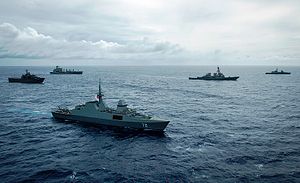Over the weekend, the United States and Singapore concluded their inaugural bilateral exercise off of Guam. The holding of the first iteration of Exercise Pacific Griffin, which has been planned since last year, represented the latest effort by the two partners to boost their defense cooperation amid shared challenges.
As I have written before, the United States and Singapore have long viewed each other as vital strategic partners, and that extends to the security realm as well. The United States is a key supplier of defense technology and facilities for military training for Singapore, while the city-state is a valuable regional partner that across a range of issues from counterterrorism to maritime security while also hosting a U.S. Navy logistics command unit that coordinates regional operations (“Strengthening the U.S.-Singapore Strategic Partnership”).
Both sides also continue to interact regularly through a string of exchanges, visits, training, and just last month, Singapore participated in the latest part of this year’s iteration of Exercise Red Flag – the U.S. Air Force (USAF) premier air-to-air combat training exercise (See: “US Air Force Exercise Kicks Off With Singapore’s Participation”). U.S. Pacific Air Forces Commander Terrence O’Shaughnessy also paid his first visit to the city-state from August 28-30 just as the two sides were carrying out Exercise Commando Sling – their longest-running air force exercise – and the Singapore Armed Forces (SAF), and the United States Marine Corps (USMC) have also just wrapped up their annual bilateral exercise Valiant Mark.
The two strategic partners also continue to upgrade and renew their series of defense engagements. One of the examples of this, as I have noted before, had been the agreement to hold a new bilateral naval exercise in Guam. Both U.S. and Singaporean officials had been highlighting the importance of the development this year because though the Republic of Singapore Navy (RSN) has been in Guam before (most recently during the Rim of the Pacific (RIMPAC) Exercise in 2014) it would be the first bilateral naval exercise between the two sides taking place outside of Singapore (See: “US, Singapore to Launch New Military Exercise in Guam”).
More broadly, it also represents an effort by both sides to increase the extent of their activities within U.S. waters and airspace, which holds value not just in terms of the bilateral relationship and its role in the region, but also for Singapore itself, which lacks the space for training its armed forces (See: “Strengthening US-Singapore Strategic Partnership: Opportunities and Challenges”). In April, the Republic of Singapore Air Force (RSAF) had carried out the first deployment of aircraft and personnel to Guam for joint training with the U.S. Air Force since discussions began between the two countries to expand training opportunities.
From August 19 to September 2, both sides carried out the first iteration of the new Exercise Pacific Griffin. The exercise involved more than 850 personnel from Singapore and the United States. According to Singapore’s defense ministry (MINDEF), Singapore’s participating assets included the frigates RSS Stalwart and RSS Supreme, the Endurance-class landing ship tank RSS Endurance, and the RSAF Sikorsky S-70B Seahawk naval helicopter, while U.S. assets included the littoral combat ship USS Coronado, Arleigh Burke-class destroyer USS Benfold, underway replenishment oiler USNS Pecos, and a P-8 Poseidon aircraft and Hawker Hunter fighter jets.
The U.S. Navy said in a statement that the activities conducted during the exercise constituted a “full spectrum” of naval operations raging from anti-submarine and anti-surface warfare to air defense, live fire drills, and tactical ship maneuvers. MINDEF said that the RSN also took the opportunity to conduct unilateral live-firings on the sidelines of Pacific Griffin, including a Designated Time-on-Target Harpoon missile live-firing involving both of the RSN frigates firing a missile each to hit the same target simultaneously. The RSS Stalwart and a Sikorsky S-70B Seahawk naval helicopter also embarked on RSS Supreme and neutralized a simulated underwater threat during a torpedo firing exercise.
































